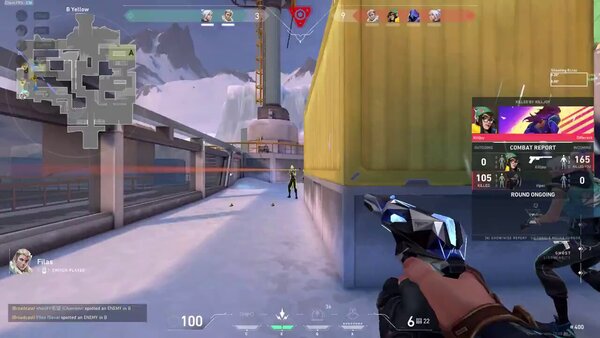Popular Now
Valorant, Riot Games’ tactical shooter, uniquely combines the mechanical precision of Counter-Strike with the hero-based gameplay of Overwatch. It’s not just about aim; it’s about timing, strategy, and teamwork. Whether you’re stepping into your first game or grinding your way out of Gold rank, this comprehensive guide will teach you how to master Valorant step by step—from the fundamentals to advanced plays. Let’s dive into what it takes to become a serious Valorant competitor.
1. Understanding Valorant Basics: Agents, Roles, and Objectives
What is Valorant?
Valorant is a 5v5 tactical first-person shooter where two teams alternate between attacking and defending over several rounds. The core gameplay revolves around either planting or defusing a spike (bomb) depending on your team’s side. Players choose from a roster of Agents, each with a unique set of abilities designed to control areas, gather intel, or engage enemies.

Know Your Agents and Roles
Each Agent falls into one of four roles: Duelists, Initiators, Controllers, and Sentinels. Knowing the difference is crucial:
-
Duelists (e.g., Jett, Reyna): Fraggers who are meant to get entry kills.
-
Initiators (e.g., Sova, Breach): Create space and initiate team fights.
-
Controllers (e.g., Omen, Brimstone): Smoke and block enemy vision.
-
Sentinels (e.g., Sage, Killjoy): Defend territory and support teammates.
Choosing an Agent that matches your strengths and learning how to support your team are your first steps toward improvement.
2. Setting Up for Success: Hardware, Settings, and Practice Tools
Optimize Your Settings
Your first goal should be ensuring that your hardware and in-game settings are helping, not hindering, your performance. Valorant is optimized to run well on most systems, but pushing for high FPS and low latency is still essential.
Key settings to optimize:
-
Mouse DPI: Stick to 400–800 DPI with a low in-game sensitivity.
-
Crosshair: Use a minimal crosshair with high contrast.
-
Minimap: Enable a rotating, player-centered minimap for awareness.
Use Aim Trainers and the Practice Range
Improving aim takes repetition and focus. Tools like Aim Lab and Kovaak’s FPS Aim Trainer allow you to train flicks, tracking, and reaction time. In-game, Valorant’s Range lets you practice recoil control and agent abilities. Start every session with at least 15 minutes of warm-up.
3. Mastering Movement and Positioning
The Importance of Movement
Movement isn’t just about getting around—it's about timing and stealth. Learning to walk silently using the Shift key and avoiding unnecessary noise can often mean the difference between life and death. Mastering counter-strafing allows you to stop instantly and fire accurately during fights.
Smart Positioning
Good positioning allows you to win fights with minimal risk. Always hold angles that force enemies to expose themselves. Use vertical elevation, off-angles, and head glitches to gain the upper hand. Reposition after firing to avoid predictability.
4. Mastering Gunplay: Recoil, Fire Modes, and Weapon Choices
Understanding Recoil and Spray Patterns
Each gun in Valorant has a unique recoil pattern. Learning how to control the Vandal or Phantom’s spray will dramatically increase your kill count. Spend time in the Range shooting at targets while slowly pulling down your mouse to compensate for recoil.

Choosing the Right Weapon
Focus on mastering a few reliable weapons:
-
Vandal: Best for long-range, one-tap headshots.
-
Phantom: Stronger for close to mid-range and better at spraying.
-
Sheriff: A powerful pistol that excels during eco rounds.
Avoid switching weapons often and instead focus on perfecting a core group.
5. Using Utility Effectively: Flash, Smoke, Recon, and Heals
Abilities Aren’t Just Extras
Abilities in Valorant can make or break a round. Using Sova’s recon bolt to scout corners or Phoenix’s flash to blind enemies can help secure kills before bullets are even fired.
Effective Timing and Placement
Utility needs to be used with purpose. Don’t throw flashes or smokes randomly. Learn map-specific lineups, such as Omen's smokes or KAY/O’s knife throws. Combine your utility with teammates’ pushes for maximum impact.
6. Communication and Teamwork: Winning as a Team
Clear and Concise Communication
Even if you’re solo queuing, use voice or text chat to communicate enemy locations, plan site executions, or call for rotates. Use the ping system if you don’t want to use a mic.
Supporting Your Team
Work around your team’s strategy. As a Sentinel, support with heals or flank protection. As an Initiator, lead pushes with flashes or recon abilities. Trading kills and peeking together are fundamental to teamwork.
7. Understanding Maps and Callouts
Map Mastery
Every map in Valorant has its quirks. Whether it’s Bind’s teleporters or Lotus’s rotating doors, learning the maps is essential. Focus on understanding:
-
Site entrances and exits
-
Common hiding spots
-
Choke points and high-traffic areas
Learn and Use Callouts
Callouts are vital for team communication. Spend time learning the standard names for locations on each map (e.g., “Heaven,” “Short,” “A Main”). This speeds up comms and makes your team more effective.
8. Economic Management and Round Strategy
Managing Credits
Credits are your economy. Losing and winning rounds impacts your buying power. Learn when to:
-
Full buy: Rifles + armor + utility
-
Eco: Save credits by buying pistols
-
Force buy: Spend all credits on the best available gear
A coordinated team economy leads to consistent power rounds and fewer handicapped rounds.
Strategic Round Planning
Each round should have a goal. Don’t rush blindly. Play for picks, fake sites, or use defaults to feel out the enemy’s positioning. After getting a pick, regroup and execute a site together.

9. Climbing Ranks: From Iron to Radiant
Understand the Ranking System
Valorant’s ranks go from Iron to Radiant. Performance is measured not only by wins but also by your personal contribution—kills, assists, damage, and clutch moments all affect progression.
Tips for ranking up:
-
Focus on one or two main Agents
-
Queue with a duo for coordination
-
Play during off-peak hours to avoid smurfs or trolls
Self-Analysis and Discipline
After each match, take 5 minutes to review what went wrong or what worked. Use stat trackers to monitor your KDA, headshot percentage, and win rate on different maps or Agents.
10. Learning from Pros: Watching, Analyzing, and Adapting
Watch Competitive Matches
Professional players offer the highest example of skill. Watch VCT games or streamers who explain their plays. Pay attention to their utility usage, decision-making, and team coordination.

Implement and Experiment
Don’t copy without understanding. Test pro strategies in custom games or unrated matches before bringing them into ranked. Build your own playbook based on tactics that suit your team or solo style.
Conclusion
Mastering Valorant requires dedication, awareness, and a desire to constantly learn and improve. By understanding your Agents, practicing aim and utility usage, working as a team, and learning from pros, you can steadily climb the ranks and elevate your game. Valorant is as much a mental and strategic game as it is a test of reflexes. Put in the work and you'll see the results.















